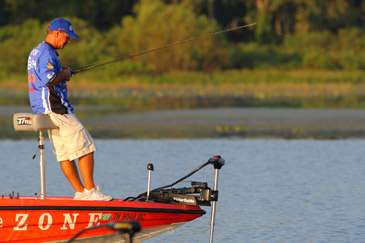
Our country is crisscrossed with thousands of miles of rivers, most of which offer bass fishing. And they're frequently close to home. That means they're just about perfect for short, inexpensive fishing trips.
Bassmaster Elite Series anglers Scott Rook and Greg Hackney live and breathe river fishing. They're some of the best in the business. In this two-part series we'll get their perspectives on how to make your trips productive as well as short and inexpensive.
Part 1: Scott Rook
"When I'm in a river system, I'm always looking at the backwater areas — especially if I'm fishing the prespawn through the spawn. Shallow areas off the main river with deep water access, cover and a north bank are perfect."
Rook makes that sound simple. But, in truth, his plan of attack is much more complicated. He isn't looking for just any shallow area or just any deep water access or just any cover or just any north bank.
"I try to avoid large, expansive flats at this time of year. The bass tend to gravitate more toward small flat spots that border ditches and cuts running along the bottom. In my mind a shallow flat might be only a foot deep. And deep water might measure 2 feet.
"My cover is mostly the standard stuff — rocks, wood and that sort of thing. But I also target dead grass. A lot of anglers don't realize how good dead grass can be at this time of year. Anytime you find a patch of it, make sure you give it a few casts.
"And your north bank needs to be open so that it gets a lot of sun during the day. A north bank in the shade is no better than any other bank. You're looking for the warmest water in the area. That requires sunshine."
Warmest doesn't mean warm to Rook, however. It means warmer than the surrounding water. In some cases the difference might be as small as 1 or 2 degrees. That may sound negligible to us humans, but to a coldblooded fish it's enormous. That's often all it takes to position bass in a tiny area and to activate a strong feeding response.
Rook's early season river bait choice is basic: a few hand poured jigs — he uses a Do-It mold — along with a handful of Texas rigged Zoom plastics and a couple of Lucky Craft RC 1.5 crankbaits in colors that match the prevailing forage.
"This is old-fashioned fishing — you don't need a lot of fancy lures. Stick to the basics and you'll be fine. Start with sizes and colors that match the local forage and then switch around if they don't work.
"Make sure you fish with heavy tackle, however. Most of the bass you catch will be big — in most parts of the country, 4- and 5-pounders are common. Stout rods, quality reels and strong line are a must."
Early Season River Bassin': Part 2




